#pitcher plants; native plants
Explore tagged Tumblr posts
Text
A walk through an autumn garden: 5 things to do at Norfolk Botanical Garden
Are you looking for ideas for a fall outing or hoping to see a holiday light show? Check Norfolk Botanical Garden.
I can’t imagine a lovelier place for a fall outing than Norfolk Botanical Garden. The garden, with its varied landscaping and many theme gardens, is arguably at its peak in the spring when the azaleas are blooming. Still, it’s surprising how many colorful blooms you’ll see on its 175 acres. Of course, the biggest attraction this season is the Dominion Energy Garden of Lights, a walk throughh a…

View On WordPress
0 notes
Text
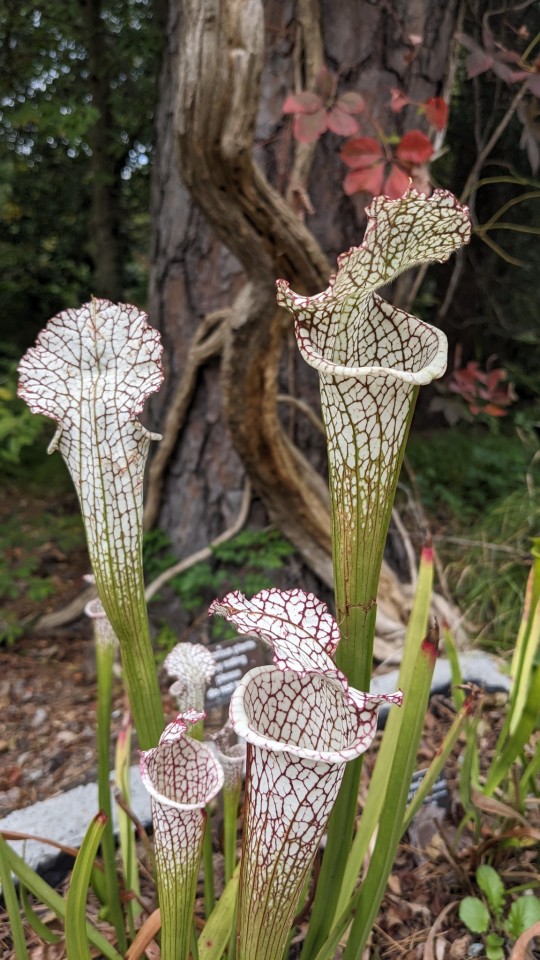
Sarracenia alata / Pale Pitcher Plant at the Sarah P. Duke Gardens at Duke University in Durham, NC
#Sarracenia alata#Sarracenia#Pale Pitcher Plant#Yellow trumpets#Pale trumpet#Pitcher Plant#Pitcher Plants#Native plants#Carnivorous Plants#Nature photography#photographers on tumblr#Sarah P. Duke Gardens#Duke Gardens#Duke University#Durham#Durham NC#North Carolina#photography#🌺🌻#Sarraceniaceae#Pitcherplant
128 notes
·
View notes
Text
mosses and the moss critters :3 and a baby katydid (unrelated)










#plants#gardening#native plants#carnivorous plant#sundews#sarracenia#pitcher plant#drosera#moss#bog#bugs
8 notes
·
View notes
Text




My little N. ventricosa has been doing so well I got brave and ordered some more carnivores! The paler nepenthes is closely related to ventracosa and the spotty one is a ventracosa hybrid, so I’m hoping they’ll do just as well. The fly trap and purple pitcher plant will be my first try doing winter dormancy. Fingers crossed!
Species in image descriptions!
#Noodling and outdoor bog garden with natives but it’s such a can of wormssssss.#How big does a raised bed need to be to insulate through the occasional polar vortex we’ve been getting?#Will putting it in an old metal bathtub make it freeze harder? Will the soil need to be changed out every few years???#I just want a mess of northern purple pitchers and bog cotton. And maybe some of the lil native sundews. But this venosa is tiding me over.#carnivorous plants#indoor plants#house plants#plantblr#venus flytrap#pitcher plants#nepenthes#Sarracenia#Look at all my new wards they’re so cute :3
6 notes
·
View notes
Text


Pitcher plants in the wild 🧡 so many lovely carnivorous plants are native to North America.
7 notes
·
View notes
Text

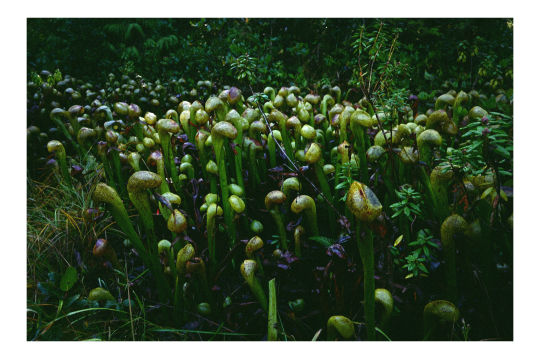
Darlingtonia's, about 200' off the highway.
Oregon Dunes National Monument, Oregon | 11-22-2023
#darlingtonia#pitcher plant#wild pitcher plant#native plants#west coast#serpentine#bog#coastal forest#forest floor#nikon#double exposure#original photographers
8 notes
·
View notes
Text
Recently started collecting carnivorous plants and we got some fruitflies and so I moved em all up into the kitchen. My new favourite activity is watching them catch the fruitflies, HIGHLY recommended. I get SUCH a kick out of it, go buy some sundews people.
#the schadenfreude when they get caught by the sundews is so great im like YES! YES!#also just put em into a little glass terrarium and keep the door open and when there were a bunch in i trapped them in#and delightedly watched as they started to get got by my sundew#i cant tell if the pitcher plant is catching any cause i cant see em#I'm being consumed by the need to buy more carnivorous plants fuck#i've got two different types of pitches and a sundew and i wanna get our native sundew since its so cute#plus i wanna get a butterwort and a venus flytrap#eventually... i shall get there...#im ignoring how many other plants i have in my room this is fine i can definitely fit more in there yup#carnivorous plants#hugin rambles#i Need To Know if the people on campus that had a pop up table are going to be selling more carnivorous plants because they had such a great#selection...
13 notes
·
View notes
Text
Plains and Barrens and Bogs, Oh My!
Places new to us and those so much more familiar rounded out the week as My Guy and I made time to explore. Our first journey found us driving over an hour and a half south and only getting fake lost as we searched for routes and a place to eat lunch. Mike’s Diner won, a hearty ham and cheese sandwich for him, and grilled cheese with tomato for me. Comfort food. And then we headed along a few…

View On WordPress
#Eastern Red-backed Salamander#Holt Pond Preserve#Kennebunk Plains#Maine#Native Orchids#Pitcher Plant#Wells Barrens Preserve#western Maine#Wood Lily
0 notes
Text

quiz: are you a marsh, swamp, bog, or fen?
#ra#forfun#uquiz#bog#marsh#fen#I WAS SO EXCITED TO GET FEN YAYYYYYYY YIPPEE WOHOOOOOO#<- spent four years living next to a high altitude fen with native pitcher plants and sundews it’s a core memory yall#I miss my mountains so baddddddd <- complained the exact same way about missing the ocean for four years#I’ll appreciate the salt marshes the way I love the fen. one day.
4K notes
·
View notes
Text
Checking out Venus Flytraps in their NATIVE habitat
Come with us as we look for the animal eating carnivorous plants in their Native habitat at Carolina Beach State Park - Venus Fly Traps, Pitcher Plants, and Sundews. We come across many other wonderous animals on our hike through the swampy area.
Come with us as we look for the animal eating carnivorous plants in their Native habitat at Carolina Beach State Park – Venus Fly Traps, Pitcher Plants, and Sundews. We come across many other wonderous animals on our hike through the swampy area. Learn more in the video by Epic Earth YouTube: Carolina Beach State Park Carnivorous Plants, North Carolina More about this subject

View On WordPress
#carnivorous plant habit#carnivorous plants#Checking out Venus Flytraps in their NATIVE habitat#pitcher plant#sundews#Venus flytrap#Venus flytrap NC#Venus flytrap north carolina
0 notes
Text
Did I just fish two crystal flies out of a pitcher plant only to catch them again?! I thought the pitcher plant would give me crystal core directly NOOOO
#genshin impact#fontaine#hyv what are pitcher plants doing in europe those are NOT native anywhereeee#or is merusea village not in fontaine???
1 note
·
View note
Text

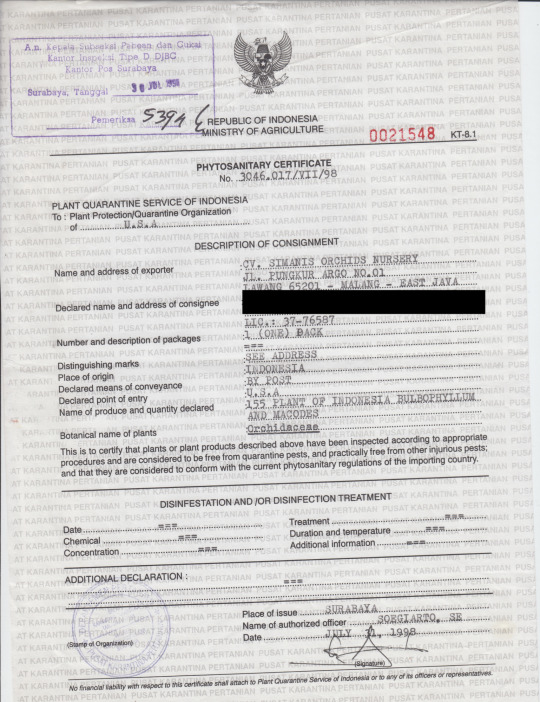
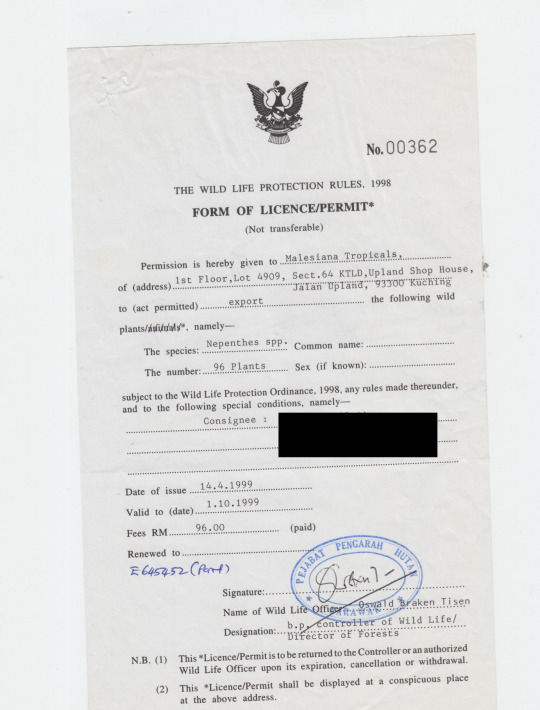

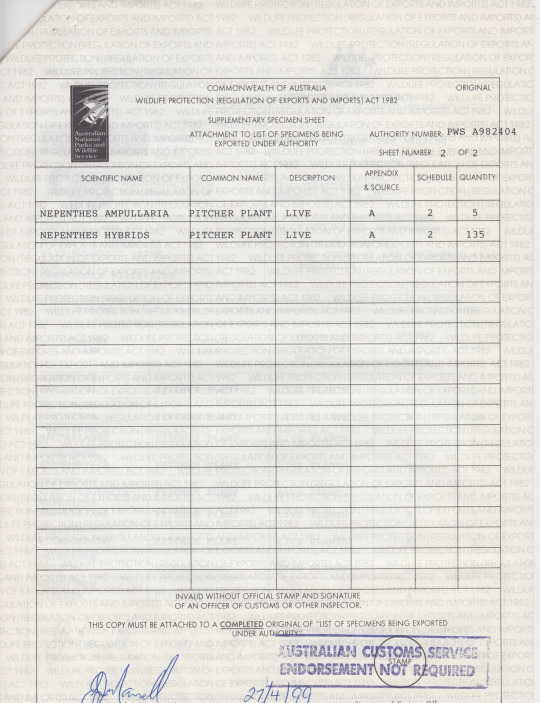
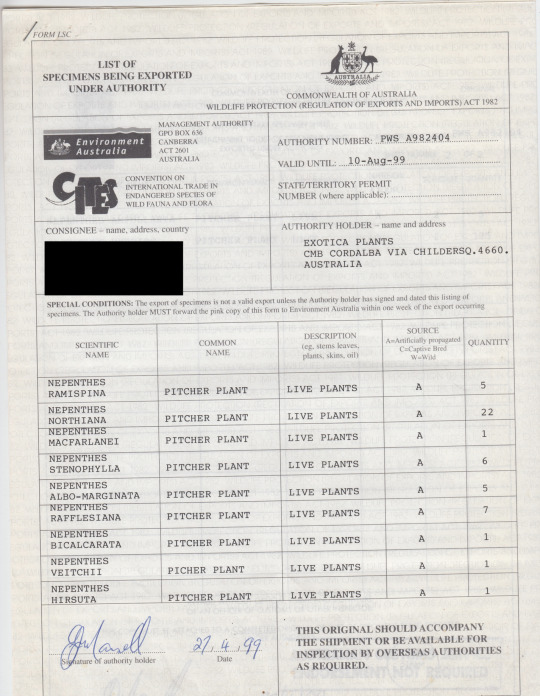
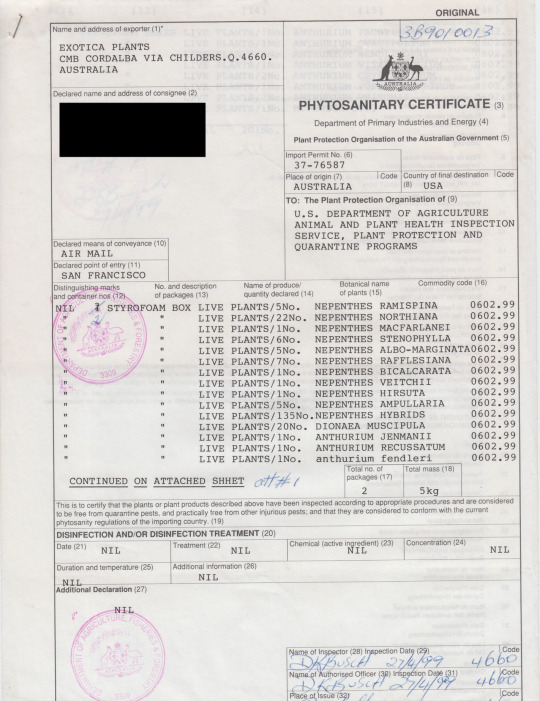
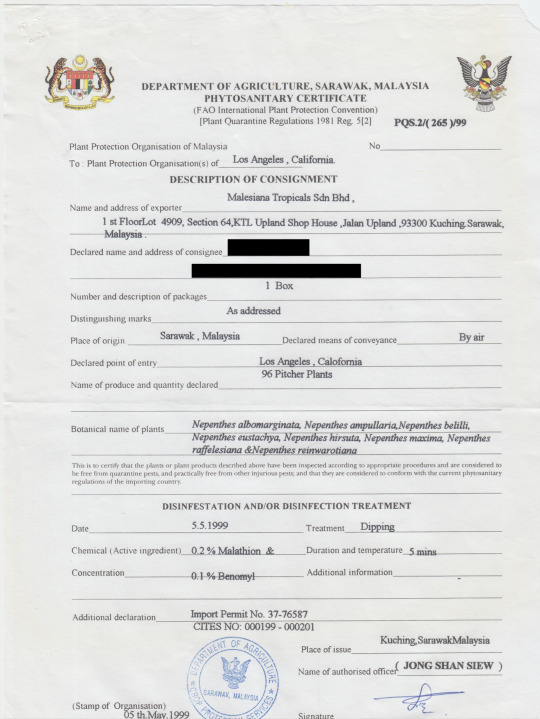
ok INCREDIBLY old content originally meant for this blog but in 2018 when i was just a wee lad with a little spinner propeller hat and big rainbow lollipop i went to a carnivorous plant convention in california and met a bunch of people who breed/collect/study these guys. one person was this collector who was slowly working on leaving the hobby or at least no longer growing plants, and he had a bunch of carnivorous plant related files he was charging like 50 cents for or something, and so i came into possession of these, which are examples of the kind of paperwork you have to have done to legally ship/trade endangered species of both plants and animals. functionally very boring paperwork, but something i found like, incredibly fascinating. i blacked out the personal id of the person and then immediately forgot to ever upload them, lmao.
these plants were bred and raised in a greenhouse and sold abroad, not taken from the wild, but because the species are endangered and often protected in their native countries (most of these are nepenthes, asian pitcher plants, a huge family spread throughout oceania and southeast asia), there's a lot more documentation that needs to be done regardless of their origin, both on the end of the seller and on the end of the buyer.
the rabbit hole on carnivorous plant trade is deep and kind of wild. there's plenty of common, non-threatened, greenhouse-grown pitcher plants on the market that people buy all the time, even non-collectors, but there's a whole debate to be had on if it's morally okay to be collecting the more endangered/rare of these plants in the first place. the big argument for breeding is that breeding them in captivity means there's more supply that's not poached from the wild, meaning poachers have less of an incentive to take the risk of taking adult plants from their habitats; from what i've heard, sometimes countries will issue permits for breeders to collect some wild seeds just to create a non-wild breeding pool to drive down the price. predictably, however, you also get people who are very much willing to pay a lot of money to get as rare of a plant as possible.
anyone familiar with the allure valuable plants have had over people throughout history can imagine the rest, but here's an article about a guy who started buying poached plants to enrich his private nepenthes collection, who then got busted by a fish and wildlife service agent embedded in his carvirorous plant circle. the plants this guy was buying were being sold to him without any CITES paperwork or declarations like the ones above; it was literally just a guy in indonesia taking rare plants from the woods around where he lived, selling them over facebook marketplace and ebay, and mailing them overseas as an undeclared 'gift' to get around customs. frighteningly small steps to take on all sides, to be honest.
(also, fun fact: another example of carnivorous plants that get poached are wild venus fly traps, which are only native to north and south carolina in the US. from what i understand it's a mix of people who genuinely did not know it's a native species and people who really are just going out into the woods and digging up plants to sell online. sometimes poaching is closer to home than you'd think!)
anyway. wild and interesting times in the land of plants recovered from a hard drive lmao
#nepenthes#annual 'plant poaching happens and it doesnt always look like the movies' post i suppose but also i think its really interesting#also the CITES system could do with an overhaul in how it approaches plants as well from what i understand but thats another thing#ive heard that like many systems like this they do not have the same urgency for plants as they do for animals#mostly because people just!! they dont get plants man!! they just say whatever its a plant!!#and poaching in general is only ever talked about like its with taking elephants for their tusks and stuff#also important conservation work but sometimes poaching really is just a guy with a shovel and that shit is WILD#carnivorous plants
525 notes
·
View notes
Text

Sarracenia alata / Pale Pitcher Plant at the Sarah P. Duke Gardens at Duke University in Durham, NC
#Sarracenia alata#Sarracenia#Sarraceniaceae#Pale Pitcher Plant#Pale Pitcherplant#Pitcher plant#Pitcherplant#Native plants#Plants#carnivorous plants#Nature photography#photography#photographers on tumblr#Sarah P. Duke Gardens#Duke Gardens#Duke University#Durham#Durham NC#north carolina#🌺🌻
16 notes
·
View notes
Text
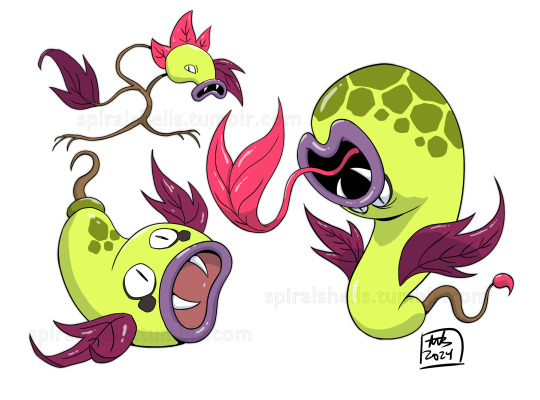
Bellsprout line variant inspired by the cobra lily, a pitcher plant native to California.
482 notes
·
View notes
Text
Life is getting harder, and so, we must get better at it.
Climate change and species extinction and ecosystem collapse are happening quickly. They are spiraling out of control. Even many Ecosystems that are supposed to be the most stable in their regions are facing decline. There are runaway effects, each thing that gets worse makes the next thing get worse faster, more disastrously. Each of these systems becomes less resilient the more of its redundancies are stripped away.
And yet, we can also have cascading effects. I am seeing controlled burns turn the plantation pines into savannas again, for the first time in 200 years, they are burning now, right now, where they would never have imagined to burn a year ago. I am seeing people talk about planting native plants. The nurseries here are selling out of them faster than they can restock. If you ask, they will say “This did not happen last year”. The foundations that have been being built by ecologists over the past half century, and maintained against brutal colonialism by indigenous peoples, are seeping out into the community. I see people talking about river cane, and pitcher plant, and planting paw paw and persimmon and sassafras and spice bush. These things are returning. Even now, in the worst drought in known history of my area, I see more butterflies than last year, because we have put in more of their host plants, their overwinters. We are learning. We are beginning. We are being born into a world of ecology; we are breaking the green wall of blur that defines our settler nonrelationship with nature. The irises are returning to Louisiana, the black bear too. The oysters are returning to Mobile Bay. I hear talk of gopher apples and river oats from the mouths of children. I see the return of the chinquapin, and her larger sister chestnut. It is slow but it is also so fast. It is growing at new trajectories, new rises. Each of these becomes it’s own advocate when planted in space and put in relationship.
We are not doomed. We must claw back from the brink. We must find each other and we must exchange seeds. We must learn to pull invasive species. We must win others over through earnestness and full bellies, through kindling the spark of ecological joy, and then we must show them the way. We must be learning the way ourselves in the meantime. We must teach the children the names we were not told, that were forgotten; how to recognize these friends.
When things are spiraling towards despair and death we must be that spiral towards life and utter utopia. We must build ourselves into full participants in our ecological systems.
As life gets harder, we must get better at it.
1K notes
·
View notes
Text





The beautiful and endangered California Lady Slipper, Cypripedium californicum, blooming in Northern California alongside Pitcher Plants, Darlingtonia Californica.
From Calflora- "Cypripedium californicum, the California lady's slipper, is a member of the orchid genus Cypripedium, the lady's slipper orchids, native to the western United States. It often grows in very large clumps and each stem can bear up to 21 flowers. It can grow to be up to over a meter in height and has alternate, plicate leaves the length of the stem. The petals and sepals tend to be greenish-brown while the small pouch is pure white with occasional pink spots.[2] Iit has a very restricted range and can only be found in the mountains of southwestern Oregon (including the Kalmiopsis Wilderness) and northern California. It prefers the margins of woodland streams in open coniferous forests."
#California Lady Slipper#Cypripedium californicum#Native Orchids#Orchids#Serpentine#forest floor#macrophotography#focus stacking#105mm#naturecore#original photographers#nature photography#photographers on tumblr#public lands#nikon photography#nikon#Native Plants#botany#protect public lands#There is no planet b
21 notes
·
View notes